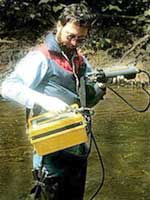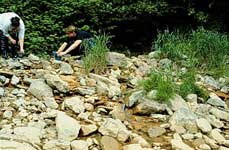
Water
Quality Assessment: Chemical
 Chemical
attributes of a waterway can be important indicators of water quality.
Chemical attributes of water can affect aesthetic qualities such as how
water looks, smells, and tastes. Chemical attributes of water can also
affect its toxicity and whether or not it is safe to use. Since the chemical
quality of water is important to the health of humans as well as the plants
and animals that live in and around streams, it is necessary to assess
the chemical attributes of water. Photo:
Professor Ken Rastall using YSI 3800 Water Quality Logger to measure several
chemical parameters of stream water quality at once. Photo courtesy of
Dr. Ben Stout.
Chemical
attributes of a waterway can be important indicators of water quality.
Chemical attributes of water can affect aesthetic qualities such as how
water looks, smells, and tastes. Chemical attributes of water can also
affect its toxicity and whether or not it is safe to use. Since the chemical
quality of water is important to the health of humans as well as the plants
and animals that live in and around streams, it is necessary to assess
the chemical attributes of water. Photo:
Professor Ken Rastall using YSI 3800 Water Quality Logger to measure several
chemical parameters of stream water quality at once. Photo courtesy of
Dr. Ben Stout.
Assessment of water quality by its chemistry includes measures of many elements and molecules dissolved or suspended in the water. Chemical measures can be used to directly detect pollutants such as lead or mercury. Chemical measures can also be used to detect imbalances within the ecosystem. Such imbalances may indicate the presence of certain pollutants. For example, elevated acidity levels may indicate the presence of acid mine drainage.
Commonly measured chemical parameters include pH, alkalinit , hardness, nitrates, nitrites and ammonia, ortho- and total phosphates, and dissolved oxygen and biochemical oxygen demand. The presence of fecal coliform, a bacteria, is also determined using a chemical test. This microscopic organism is too small to detect during the biological assessment of macroinvertebrate populations. In addition, some "chemical" measurements actually indicate the physical presence of pollutants in water. These include measurements such as conductivity and density.
 Measurements
of these chemical parameters of water quality can be made one at a time
using low-tech field titration kits such as Hach Kits (see left). However,
several of these parameters may be measured at once using high-tech equipment
such as the YSI 3800 Water Quality Logger (see above). Photo:
Students using Hach Kits to measure several chemical parameters of stream
water quality one at a time. Photo courtesy of Dr. Ken Rastall.
Measurements
of these chemical parameters of water quality can be made one at a time
using low-tech field titration kits such as Hach Kits (see left). However,
several of these parameters may be measured at once using high-tech equipment
such as the YSI 3800 Water Quality Logger (see above). Photo:
Students using Hach Kits to measure several chemical parameters of stream
water quality one at a time. Photo courtesy of Dr. Ken Rastall.
Overview ..|.. Biological Assessment ..|.. Chemical Assessment ..|.. Physical Assessment.
pH
/ Alkalinity / Hardness
/ Nitrates. Nitrites, and Ammonia / Ortho-
and Total Phosphate / Dissolved Oxygen and
Biochemical Oxygen Demand / Fecal Coliform
/ Conductivity and Density
Glossary
.|. Related Links
.|..
References
..|..
PBL Model
.|
Home ..|.. Teacher Pages ..|.. Modules & Activities
HTML code by Chris Kreger
Maintained by ETE Team
Last updated November 10, 2004
Some images © 2004 www.clipart.com
Privacy Statement and Copyright © 1997-2004 by Wheeling Jesuit University/NASA-supported Classroom of the Future. All rights reserved.
Center for Educational Technologies, Circuit Board/Apple graphic logo, and COTF Classroom of the Future logo are registered trademarks of Wheeling Jesuit University.
